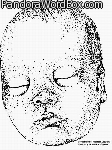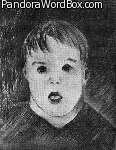|
×  Get the Point! PAIN – WOMAN – UKRAINE – PUTIN MOTHER – SISTER – SPOUSE – MOTHER RUSSIAN WAR – HOLOCAUST – GENOCIDE |
SYNDROME > SIGN - SYMPTOM > SYNDROME > SEMIOLOGY
Prototype - Down Syndrome (DS)
Emphasis on Dysmorphology
Part A
Note - Clinical Eye Openers (CEO) offers a Dysmorphology (A) Tutorial (20 moducles inclusive of 29 Clinican Videos)
Part A
The most prevalent visualy perceptible dysmorphic signs in individuals with DS (malformations, deformations and unusual "shapes" or morphogenesis) are hlighted below. Many dysmorphic signs are noticeable among "normal" persons but in DS and other "dysmorphic syndromes" such signs are more frequent andd are multiple. Average persons may have few dysmorphic signs but few persons have more that 2 or 3 dysmorphic signs. Any person with 5 or more dysmorphic signs is more likely to have malfromations consequential to normal health and develpment.
It is useful to rely on a perspective stressing notions inherent in the terms symptom - sign - signal - syndrome. Symptoms are subjective (reported by patients) - signs are objective (physically detectable) - syndrome implies concurrence (often recurrent) of combinations of symptoms-signs. An individual may have several clusters of concurrent syndromes (e.g. blindness-sunken eyes - leg paralysis-leg muscular atrophy) - in some disorders the syndrome A and B just described are concurrent and suggesteve of a particular pathogenesis (mechanism, in this instance, in common). Any hypothetical cause (etiology) should be consistent as a cause of blindness and limb paralysis.
Note that no symptom nor sign is pathognomonic (specific) of DS nor of most other syndromes.
Down syndrome (DS) or formerly "Mongolism" can be visually recongnized by professionals and lay persons alike - this capacity illustrates the importance of "trained eyes" - the capacity to see "stigmata" (typical signs of a particular disorders) is illustrated by the icons above and below. (click on the icons for more details) - Among the most constant (stigmatic - but not specific) DS signs (stigmata) are:
> at birth; reduced head and body size and hypotonia (floppy baby)
> infancy; discovery of internal malformations (cardiac, intestinal, ...)
> childhood; hearing loss, delayed development and intellectual defficits
> adulthood; diabetes ... premature aging, senility, dementia
The "natural history" is characteristic (predictable course, path or pathogenesis) - the infants do not grown nor develop as much as average infants - furthermore, DS infancts face the risk of predictable complcations - thus anticipatory care is possible and essential - see preventive strategies summarized in http://www.ibis-birthdefects.org/start/dsfact.htm
20161008 ww










